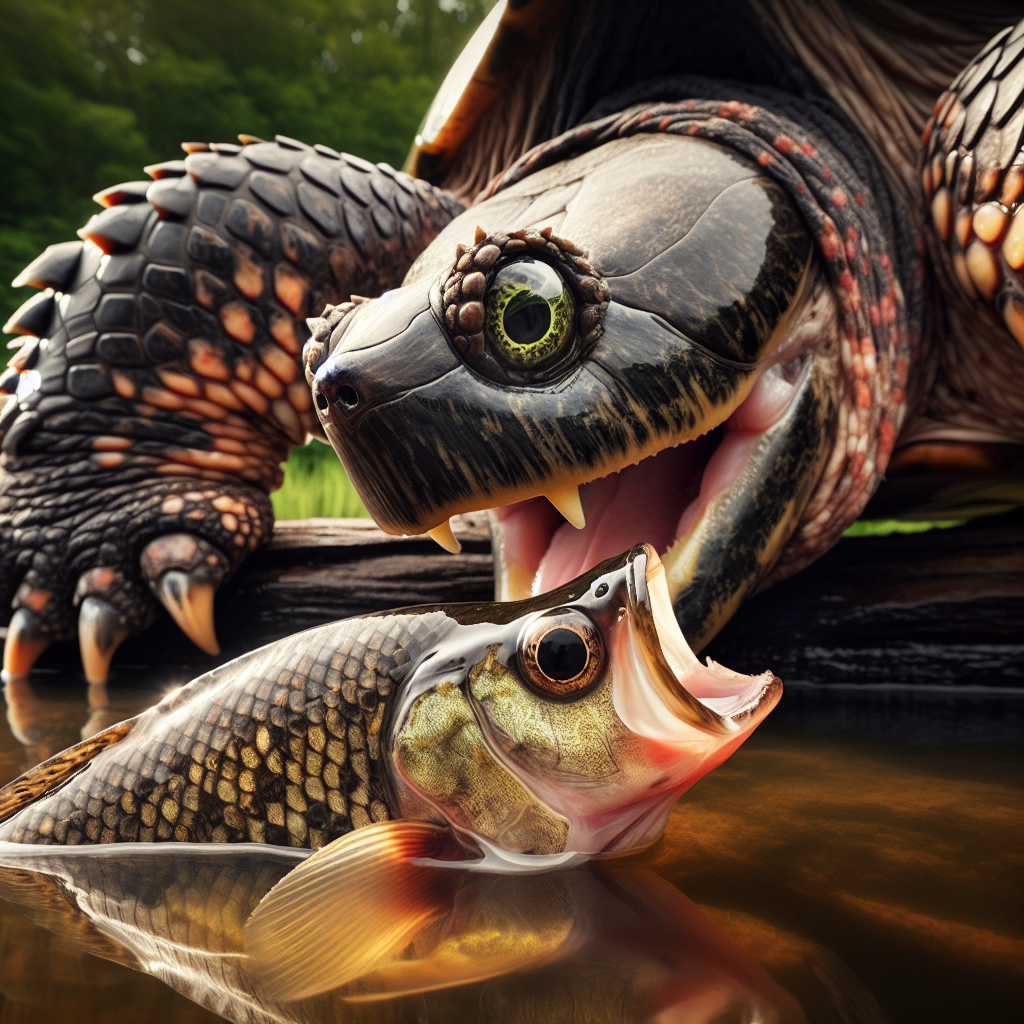Have you ever wondered what snapping turtles, those fascinating creatures, enjoy feasting on? Well, you’re in for a treat! In this article, we will uncover the dietary preferences of these intriguing reptiles. From crunchy crayfish to small fish and even vegetation, snapping turtles have quite the eclectic taste. So grab a seat and prepare to delve into the world of snapping turtle cuisine!

Habitat of Snapping Turtles
Freshwater Habitats
Snapping turtles are primarily found in freshwater habitats, such as lakes, ponds, rivers, and marshes. They are well-adapted to living in these environments due to their ability to swim and their preference for water bodies with abundant vegetation. Freshwater habitats provide these turtles with the necessary resources for survival, including food sources and shelter. Snapping turtles are known to spend a significant amount of time submerged in the water, using their muscular legs and powerful tails to navigate and hunt for prey.
Terrestrial Habitats
While snapping turtles are primarily aquatic creatures, they also require access to terrestrial habitats for various activities, including nesting and hibernation. These turtles often venture onto land to lay their eggs, which they bury in holes dug in sandy or loose soil. Terrestrial habitats provide a safe and suitable environment for the incubation of their eggs. Additionally, snapping turtles may also move between water bodies and terrestrial habitats during migration or when seeking new sources of food.
Migration
Snapping turtles are known to undertake seasonal migrations to fulfill their specific needs. During the mating season, which usually occurs in the spring or early summer, female snapping turtles may travel considerable distances to find suitable nesting sites. By migrating to these sites, they ensure the protection and survival of their offspring. Some snapping turtles also migrate between different water bodies or habitats in search of food or to escape unfavorable conditions, such as low water levels or environmental disturbances.
Dietary Preferences of Snapping Turtles
Carnivorous Behavior
Snapping turtles are carnivorous reptiles that have a diverse diet. They have a strong preference for animal-based foods, which form a significant part of their diet. Their carnivorous behavior stems from their sharp beaks, powerful jaws, and strong muscles that enable them to seize and consume their prey. However, while snapping turtles primarily rely on animal matter for sustenance, they may also consume plant matter opportunistically.
Aquatic Prey
As aquatic predators, snapping turtles prey on a wide range of animals that inhabit freshwater environments. Their diet often includes fish, such as small bass, perch, catfish, and sunfish. They may also feed on amphibians like frogs, toads, and salamanders, as well as reptiles such as snakes, turtles, and even young alligators. Additionally, snapping turtles are known to consume birds and their eggs when they come into contact with them.
Opportunistic Feeders
Snapping turtles are highly opportunistic feeders and will consume whatever prey is most readily available to them. They possess a remarkable ability to adapt their diet based on the availability of food sources in their environment. This adaptability allows them to thrive in various ecosystems and enables them to survive even during periods of scarcity. Snapping turtles are known to take advantage of situations where food is abundant, utilizing these opportunities to fulfill their nutritional requirements.
Scavenging Behavior
In addition to actively hunting for prey, snapping turtles are also scavengers, playing an important role in the ecosystem as decomposers. They feed on carrion, including dead animals and decaying organic matter, which helps in the recycling of nutrients. By consuming carcasses and decomposing animals, snapping turtles contribute to the cleanup of their habitat and prevent the spread of disease. This scavenging behavior showcases their ability to adapt their feeding habits to the available resources in their environment.
Natural Prey of Snapping Turtles
Fish
Fish comprise a significant portion of a snapping turtle’s diet. They are opportunistic predators in aquatic environments and actively hunt for various species of fish. Snapping turtles employ their stealthy, ambush-style hunting strategy to surprise and capture fish swimming by. Their sharp beaks and powerful jaws enable them to hold onto struggling fish securely, ensuring successful predation.
Amphibians
Snapping turtles also feed on amphibians, including frogs, toads, and salamanders. They are skilled at locating these creatures around shallow areas of freshwater habitats. Snapping turtles use their keen senses, such as their excellent sense of smell and sight, to detect the presence of amphibians. Once spotted, they swiftly seize and consume these prey items.
Reptiles
Snapping turtles are not averse to preying on their fellow reptiles. They are opportunistic predators that may target smaller turtles, snakes, and even young alligators. Snapping turtles use their sharp jaws and strong muscles to overpower their reptilian prey. Their powerful bite enables them to break through the shells of turtles or immobilize snakes, providing them with a reliable source of food.
Birds
While not their primary prey, snapping turtles occasionally consume birds and their eggs when given the opportunity. They may target waterfowl, such as ducks or geese, as well as smaller bird species that venture near the water’s edge. Snapping turtles use their sharp beaks to grab birds or their eggs, ensuring a sufficient food supply in times when other prey may be scarce.
Small Mammals
Snapping turtles are known to feed on small mammals that inhabit the areas surrounding their freshwater habitats. They may target rodents, such as mice or rats, as well as other small mammals like shrews or chipmunks. Snapping turtles exhibit patience and opportunism when it comes to capturing mammals, relying on their ambush tactics or chasing them down when the opportunity arises.
Invertebrates
While snapping turtles primarily consume vertebrate prey, they are also known to feed on various invertebrates. This includes insects, crustaceans, mollusks, and worms. Invertebrates form an essential part of their diet, especially during early stages of development when snapping turtles are smaller and less capable of capturing larger prey. These invertebrates provide a valuable source of nutrients, contributing to their growth and survival.
Aquatic Plant Matter Consumption by Snapping Turtles
Algae
Although snapping turtles are mainly carnivorous, they occasionally consume small amounts of algae. Algae are plant-like organisms that thrive in freshwater environments, providing a readily available food source for opportunistic feeders like snapping turtles. While not a significant portion of their diet, the consumption of algae may occur when other food sources are scarce or during periods of low activity.
Seaweeds
Snapping turtles are not typically found in marine environments, and therefore, seaweeds are not a common part of their diet. Seaweeds refer to various types of large algae that grow in saltwater environments. However, there have been rare instances where snapping turtles have been observed consuming small amounts of seaweed, either accidentally or as a result of feeding on other marine organisms.
Aquatic Vegetation
Snapping turtles occasionally consume aquatic vegetation, such as submerged plants, floating plants, or emergent plants. While they are not specialized herbivores, they may opportunistically feed on these plant types when available. Aquatic vegetation can provide snapping turtles with additional nutrients and minerals not found in their primarily carnivorous diet. Additionally, it can serve as a source of shelter, particularly for younger turtles.

Other Food Sources for Snapping Turtles
Carrion and Decomposing Animals
Apart from actively hunting live prey, snapping turtles scavenge for carrion and decomposing animals. They play a crucial role in ecosystem balance by consuming dead animals and decaying organic matter. Snapping turtles use their powerful jaws to tear apart and consume carcasses, aiding in the decomposition process and preventing the spread of disease.
Unconventional Prey
Snapping turtles have been known to consume unconventional prey items when given the opportunity. This may include items such as fruits, vegetables, or even human food scraps that find their way into their habitat. While these items are not a fundamental part of their diet, snapping turtles’ adaptability allows them to utilize alternative food resources when available.
Hunting Strategies of Snapping Turtles
Ambush Predators
Snapping turtles employ an ambush-style hunting strategy to capture their prey. They patiently lie in wait, partially buried in the substrate or concealed underwater vegetation, with only their eyes and nostrils visible. This camouflage allows them to blend seamlessly with their surroundings, remaining undetected by unsuspecting prey until the perfect moment to strike.
Patience and Waiting for Prey
Snapping turtles are masters of patience, often remaining motionless for extended periods while waiting for prey to come within striking distance. Their ability to stay perfectly still for extended periods, combined with their excellent eyesight and camouflage, enables them to successfully ambush and capture unsuspecting prey animals.
Lunge Strike
When prey comes within range, snapping turtles exhibit a lightning-fast lunge strike. They rapidly extend their necks, using their long, slender tongues to draw prey into their powerful jaws. Snapping turtles possess impressive speed and accuracy during their strike, making it challenging for prey to escape once within their reach.
Jaw Power and Chasing
Snapping turtles possess incredibly strong jaws, and once they have captured their prey, it is difficult for the prey to escape. Snapping turtles often use their powerful jaw muscles to crush and immobilize their prey, preventing it from fleeing. In some cases, snapping turtles may also engage in short chases to capture prey that attempts to evade their initial strike.
Jaw Strength and Capabilities of Snapping Turtles
Powerful Bites
Snapping turtles are renowned for their powerful bites, with some individuals capable of exerting enormous force to capture and immobilize their prey. Their sharp beaks and jaw strength allow them to deliver crushing bites that can penetrate defensive armor or bone, ensuring successful predation.
Crushing Prey
Snapping turtles utilize their robust jaw muscles to crush the shells of turtles or hard exoskeletons of crustaceans. This ability is crucial for capturing and consuming a wide range of prey, including animals with protective structures that would be challenging for other predators to overcome.
Ability to Sever
Snapping turtles have the ability to sever body parts of certain prey items when necessary. This can be particularly advantageous when dealing with larger or more dangerous prey. By severing limbs or other body segments, snapping turtles can neutralize the threat posed by their prey while ensuring a more manageable meal.
Distinctive Diet Adaptations in Snapping Turtles
Hooded and Musk Turtles
Hooded and musk turtles, both closely related to snapping turtles, have distinct dietary adaptations. While they share similar aquatic habitats, these species are primarily herbivorous. They consume a diet consisting of aquatic vegetation, such as algae, duckweed, and other water plants. The specialized adaptations of their jaws and digestion allow them to efficiently process and extract nutrients from the plant matter they consume.
Alligator Snapping Turtles
Alligator snapping turtles, a large and powerful species of snapping turtle, have unique dietary adaptations compared to other snapping turtles. They are known to be primarily carnivorous, utilizing their powerful jaws and size to capture larger prey items. Their diet often includes fish, amphibians, and small mammals. Alligator snapping turtles have been known to use a specialized lure on their tongue to attract prey, making them highly effective hunters in their habitat.
Macroclemys Turtles
Macroclemys turtles, also known as the giant snapping turtles or loggerhead turtles, have distinctive dietary adaptations. These turtles are known for their preference for mollusks, such as clams and snails. Their strong jaws and elongated necks allow them to crush the hard shells of these prey items, enabling them to access the soft tissues inside.
Role of Snapping Turtles in the Ecosystem
Natural Predators
Snapping turtles play a crucial role in aquatic ecosystems as natural predators. Their predatory behavior helps regulate the populations of various prey species, preventing overpopulation and maintaining ecological balance. By controlling populations of fish, amphibians, reptiles, and other aquatic organisms, snapping turtles contribute to the overall health and stability of their ecosystem.
Carcass Cleanup
Snapping turtles contribute to the decomposition process by scavenging and consuming carrion and decomposing animals. Their feeding on dead animals helps break down organic matter and recycle nutrients back into the environment. This cleanup role is essential in maintaining the overall cleanliness and health of their habitat and preventing the spread of disease.
Seed Dispersers
Snapping turtles inadvertently contribute to seed dispersal by consuming fruits and vegetation. After consuming plant matter, the seeds may pass through their digestive system and be deposited in different areas through their excrement. This process aids in seed dispersal, allowing for the potential establishment and growth of various plant species across different environments.
Conservation Status and Threats to Snapping Turtles
Habitat Destruction
Habitat destruction poses a significant threat to snapping turtles worldwide. Loss of wetlands, pollution of freshwater bodies, and urbanization lead to habitat degradation, fragmentation, and loss. These changes can disrupt their access to suitable nesting sites, feeding areas, and hibernation locations, ultimately impacting their populations.
Human Interaction
Human interaction, including accidental encounters with boats or vehicles, can pose risks to snapping turtles. Collisions with boats and vehicles can lead to severe injuries or death for turtles attempting to cross roads or navigate busy waterways. To mitigate these risks, measures such as wildlife underpasses and nesting site protection are necessary to ensure the long-term survival of snapping turtle populations.
Poaching
Snapping turtles are sometimes subjected to poaching, either for their meat or for the illegal pet trade. Overharvesting of these turtles can have detrimental effects on their populations, further compounded by their slow reproductive rates. Strict regulations, enforcement of wildlife protection laws, and public education are essential in combating illegal trade and poaching.
Pollution
Pollution, particularly water pollution, poses a significant threat to snapping turtles. Chemical contaminants, such as pesticides, heavy metals, and plastics, can accumulate in the water bodies where these turtles reside. Pollution interferes with their habitat quality, contaminates their prey, and can lead to poisoning or other health issues. Addressing pollution through environmental regulations and conservation efforts is crucial for the survival of snapping turtles and the ecosystems they inhabit.
